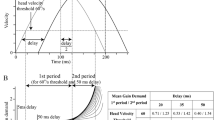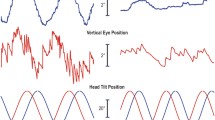Abstract.
The three pairs of semicircular canals within the labyrinth are not perfectly aligned with the pulling directions of the six extraocular muscles. Therefore, for a given head movement, the vestibulo-ocular reflex (VOR) depends upon central neural mechanisms that couple the canals to the muscles with the appropriate functional gains in order to generate a response that rotates the eye the correct amount and around the correct axis. A consequence of these neural connections is a cross-axis adaptive capability, which can be stimulated experimentally when head rotation is around one axis and visual motion about another. From this visual-vestibular conflict the brain infers that the slow-phase eye movement is rotating around the wrong axis. We explored the capability of human cross-axis adaptation, using a short-term training paradigm, to determine if torsional eye movements could be elicited by yaw (horizontal) head rotation (where torsion is normally inappropriate). We applied yaw sinusoidal head rotation (±10°, 0.33 Hz) and measured eye movement responses in the dark, and before and after adaptation. The adaptation paradigm lasted 45–60 min, and consisted of the identical head motion, coupled with a moving visual scene that required one of several types of eye movements: (1) torsion alone (-Roll); (2) horizontal/torsional, head right/CW torsion (Yaw-Roll); (3) horizontal/torsional, head right/CCW torsion (Yaw+Roll); (4) horizontal, vertical, torsional combined (Yaw+Pitch-Roll); and (5) horizontal and vertical together (Yaw+Pitch). The largest and most significant changes in torsional amplitude occurred in the Yaw-Roll and Yaw+Roll conditions. We conclude that short-term, cross-axis adaptation of torsion is possible but constrained by the complexity of the adaptation task: smaller torsional components are produced if more than one cross-coupling component is required. In contrast, vertical cross-axis components can be easily trained to occur with yaw head movements.
Similar content being viewed by others
Author information
Authors and Affiliations
Additional information
Electronic Publication
Rights and permissions
About this article
Cite this article
Trillenberg, .P., Shelhamer, .M., Roberts, .D. et al. Cross-axis adaptation of torsional components in the yaw-axis vestibulo-ocular reflex. Exp Brain Res 148, 158–165 (2003). https://doi.org/10.1007/s00221-002-1285-4
Received:
Accepted:
Issue Date:
DOI: https://doi.org/10.1007/s00221-002-1285-4




